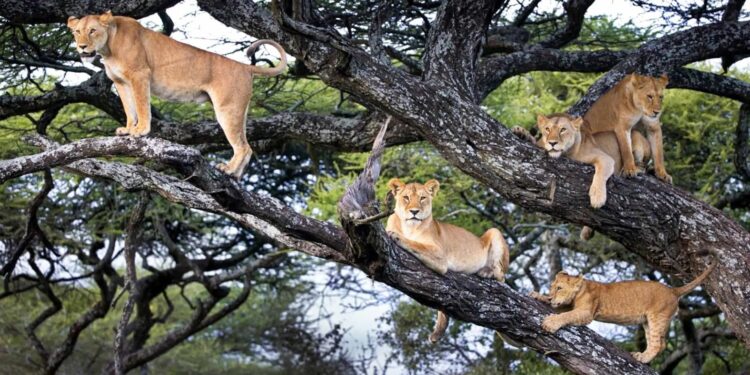Queen Elizabeth National Park, which is tucked away in the centre of Uganda, is a monument to the amazing biodiversity of that nation. The park is well-known for one of its many marvels: tree-climbing lions, an uncommon and fascinating phenomenon. With this writing, we set out to investigate the mysteries and distinctive habits of these mighty hunters that challenge the common perception of lions lounging in the grasslands.
Elizabeth National Park: A Refuge for Animals: With a land area of more than 1,978 square kilometres, Queen Elizabeth National Park is a hotspot for biodiversity and is home to a wide variety of plants and animals. The park’s open savannahs, thick forests, and breathtaking view of the Rwenzori Mountains provide the ideal habitat for a variety of animals, including the well-known tree-climbing lions.
The Strange Ways in Which Lions Climb Trees: The lions of Queen Elizabeth National Park have acquired the unusual habit of climbing trees, unlike their counterparts in other regions of Africa. Though numerous theories have surfaced, the reasons for this behaviour remain a source of scientific curiosity. While some experts speculate that climbing trees gives these lions a better vantage point for spotting prey, others think it only helps them escape the swarming flies and find cooler temperatures.
Favourite Locations and Hotspots: One of Queen Elizabeth National Park’s most common sights for visitors is seeing lions relaxing on the limbs of enormous fig and acacia trees. This behaviour is especially well-known in the Ishasha sector, which is found in the park’s southern region. It is a breathtaking sight to see a lion resting contentedly on a strong branch with the stunning African scenery in the background.
Conservation Challenges: Although the lions that scale trees have come to represent Queen Elizabeth National Park, there are still issues that threaten their survival. For these rare predators, poaching, habitat loss, and conflicts with humans and wildlife present serious risks. The iconic inhabitants of the park depend on conservation efforts to survive.
Tourism and Conscientious Viewing: Queen Elizabeth National Park has become a popular destination for wildlife enthusiasts and photographers due to the presence of tree-climbing lions. When properly handled, tourism can help save these lions by raising money for conservation initiatives. To reduce disturbance to the animals and their habitat, ethical tourism practices must be promoted.
The Prospects for Lions That Climb Trees: It’s important to think about the lions of Queen Elizabeth National Park’s future as we admire their ability to climb trees. To maintain the delicate balance of this special ecosystem, cooperation between local communities, wildlife authorities, and conservation organisations is essential. We can guarantee that future generations will continue to see the amazing sight of lions gracefully perched in the branches of Uganda’s trees by funding conservation initiatives.
Queen Elizabeth National Park’s tree-climbing lions are a fascinating illustration of how nature can astonish and enchant us. In addition to examining and appreciating these distinctive behaviours, let us pledge to protect these magnificent animals and their habitat, so that the enchantment of Uganda’s tree-climbing lions will endure for many more generations.
Do you have a story in your community or an opinion to share with us: Email us at editorial@watchdoguganda.com









